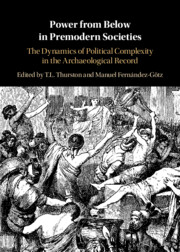 Power from Below in Premodern Societies
Power from Below in Premodern Societies Labile Elite Power Structures in Early Iron Age Europe
Published online by Cambridge University Press: 08 October 2021
This excerpt is from the Declaration of Arbroath, which was sent in 1320 with the signatures of 38 Scots noblemen to Pope John XXII in Avignon. The document is an expression of support for Robert I, also known as The Bruce, the leader of one of several competing polities in Scotland in the 14th century. Its other purpose was to petition the pope to persuade the English, led at the time by Edward I, also known as Malleus Scotorum, or “The Hammer of the Scots,” to cease hostilities against Scotland. (To be fair, he hammered the Welsh and diverse infidels in the Holy Land during the Ninth Crusade as well; hammering seems to have been his thing.) The term the Scots nobles used in the Declaration to describe their polity was nacio, usually translated as “the people,” which of course did not mean what it does today – women, children and landless males too old or poor to count were implicitly included but had no actual power over their own persons.
To save this book to your Kindle, first ensure [email protected] is added to your Approved Personal Document E-mail List under your Personal Document Settings on the Manage Your Content and Devices page of your Amazon account. Then enter the ‘name’ part of your Kindle email address below. Find out more about saving to your Kindle.
Note you can select to save to either the @free.kindle.com or @kindle.com variations. ‘@free.kindle.com’ emails are free but can only be saved to your device when it is connected to wi-fi. ‘@kindle.com’ emails can be delivered even when you are not connected to wi-fi, but note that service fees apply.
Find out more about the Kindle Personal Document Service.
To save content items to your account, please confirm that you agree to abide by our usage policies. If this is the first time you use this feature, you will be asked to authorise Cambridge Core to connect with your account. Find out more about saving content to Dropbox.
To save content items to your account, please confirm that you agree to abide by our usage policies. If this is the first time you use this feature, you will be asked to authorise Cambridge Core to connect with your account. Find out more about saving content to Google Drive.